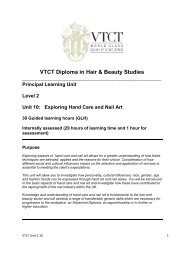Observations - VTCT
Observations - VTCT
Observations - VTCT
Create successful ePaper yourself
Turn your PDF publications into a flip-book with our unique Google optimized e-Paper software.
68<br />
Outcome 2: Be able to provide spa treatments (continued)<br />
Functions of the skin – protection,<br />
heat regulation, absorption, secretion,<br />
elimination, sensation, formation of<br />
Vitamin D, melanin production, process of<br />
keratinisation.<br />
Examples of skin diseases and<br />
disorders:<br />
Congenital – eczema, psoriasis.<br />
Bacterial – acne vulgaris, acne rosacea,<br />
folliculitis, boils (furuncles), impetigo.<br />
Viral – warts, verruca, herpes simplex<br />
(HSV), herpes zoster.<br />
Fungal – tinea (pedis, corporis, ungium).<br />
Infestations – scabies, pediculosis<br />
(capitas, pubis).<br />
Pigmentation – vitiligo, albinism,<br />
chloasma, ephelides, lentigo, papilloma,<br />
naevae, port/wine stains.<br />
Others – basal cell carcinoma, squamous<br />
cell carcinoma, malignant melanomas.<br />
Cardiovascular system structure:<br />
Heart – wall (endocardium, myocardium,<br />
pericardium), aorta, atria, bicuspid (mitral)<br />
valve, chordae tendineae, inferior and<br />
superior vena cava, papillary muscles,<br />
pulmonary artery, pulmonary vein,<br />
semilunar valves (aortic and pulmonary),<br />
septum, tricuspid valve, ventricles.<br />
Blood vessels – arteries, arterioles, veins,<br />
venules, capillaries.<br />
Circuits – pulmonary circulation, portal<br />
circulation, coronary circulation, systemic<br />
circulation.<br />
Major arteries of the head and neck –<br />
carotid, facial, occipital, temporal.<br />
UV30448<br />
Major veins of the head and neck –<br />
jugular, occipital, temporal, maxillary, facial.<br />
Major arteries of the body – aorta,<br />
descending aorta, subclavian, carotid,<br />
pulmonary, hepatic, splenic, renal,<br />
mesenteric, iliac, vertebral, axillary,<br />
brachial, ulnar, radial, palmar arch, femoral,<br />
popliteal, anterior tibial, plantar arch.<br />
Major veins of the body – vena cava<br />
(inferior and superior), pulmonary, hepatic,<br />
splenic, renal, iliac, axillary, brachial,<br />
basilica, cephalic, subclavian, saphenous<br />
(long and short), venous arch, femoral,<br />
popliteal, posterior tibial, anterior tibial.<br />
Blood – plasma, leucocytes (granulocytes<br />
and agranulocytes), erythrocytes,<br />
thrombocytes.<br />
Cardiovascular functions: Transport,<br />
defence, clotting, regulation and<br />
homeostasis.<br />
Lymphatic system structure: Lymph,<br />
lymph capillaries, lymphatic vessels,<br />
lymph nodes, lymphatic trunks, lymphatic<br />
ducts (thoracic and right lymphatic duct),<br />
subclavian veins, nodes (axillary, cervical<br />
(superficial and deep), inguinal, intestinal,<br />
occipital, popliteal, post-auricular, parotid,<br />
supratrochlear), appendix, peyers patches,<br />
spleen, tonsils, thymus.<br />
Lymphatic functions: Subsidiary<br />
circulation (lymph formation), immunity,<br />
return of lost plasma proteins to the blood,<br />
transport dietary lipids.<br />
Nervous system structure:<br />
Central Nervous System (CNS) – brain,<br />
spinal cord, white matter, grey matter,<br />
meninges (pia mater, arachanoid mater,<br />
subarachanoid space, dura mater),<br />
cerebrospinal fluid, blood brain barrier,
















